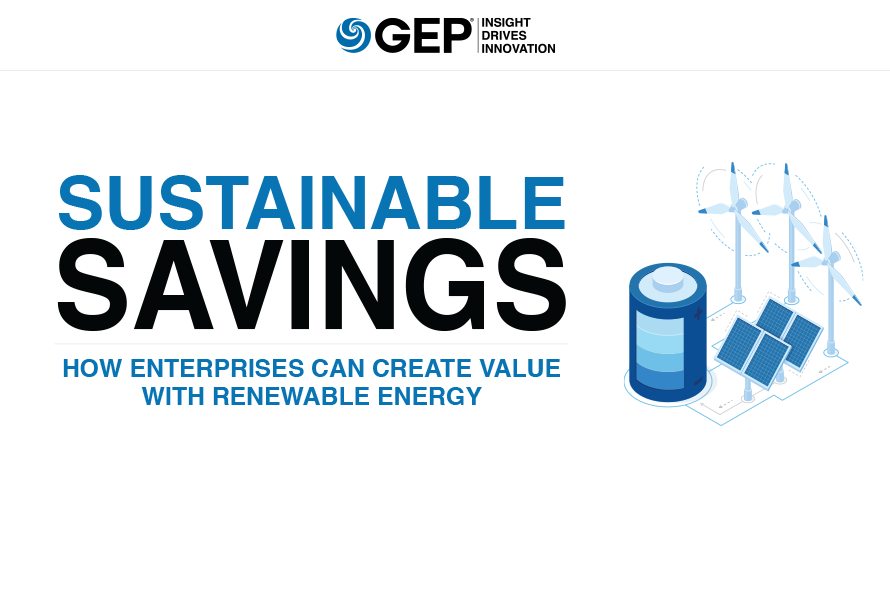The future depends on sustainable solutions that need to happen now. Luckily, companies don’t need to sacrifice affordability to reap the benefits of renewable energy.
Our new white paper, Sustainable Savings: How Enterprises Can Create Value With Renewable Energy, makes a strong case for shifting from traditional, grid-based energy to renewable power. Our energy experts reveal why companies in the energy industry must make the switch, share the leading options for transitioning to green energy, and show the undeniable benefits of thinking — and acting — sustainably.
What’s Inside:
- The urgent need for renewables
- Three leading clean energy options
- The business benefits of sustainable power
This paper is a must-read for procurement and business leaders who want to meet sustainability goals, improve their bottom line and build customer loyalty.
Climate change presents an unparalleled threat to business profitability. Supply chain disruptions, resource scarcity and price volatility are only a few of the climate risks that firms must address if they want to survive. In addition to these direct risks, consumers and investors are now demanding that corporations go beyond the bare minimum to proactively address their environmental impact.
Renewable energy solutions offer a financially and environmentally sound response to this unique combination of risks. By switching to renewable energy sources, organizations will not only reduce greenhouse gas emissions and contribute to a cleaner environment but also capture significant savings.
This white paper explores how environmentally conscious companies, led by their procurement teams, can transition to clean energy and lower utility bills, reduce their carbon footprints and increase customer loyalty — a trifecta that provides a clear competitive advantage.
HOW WE GOT HERE
The greenhouse gases in Earth’s atmosphere create habitable temperatures, but human activities have overwhelmed the planet with unprecedented levels of emissions, raising global temperatures. Over the last century, the burning of fossil fuels such as coal, oil and natural gas has increased the atmospheric concentration of carbon dioxide (CO2), a greenhouse gas, to unprecedented levels. Because traditional electricity generation depends on the burning of such fossil fuels, increased consumption is directly related to increased CO2 emissions.1
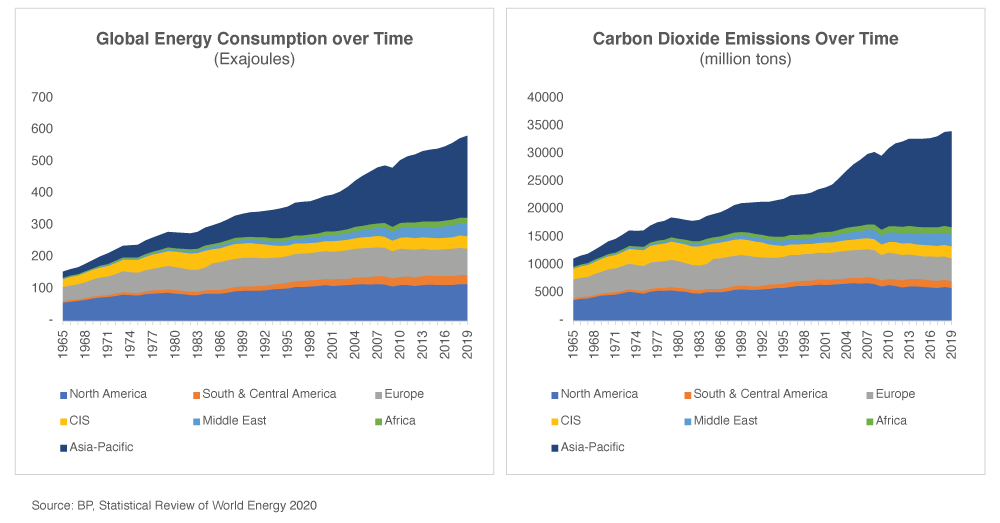
DEFINING SUSTAINABILITY
For the context of this paper, sustainability is the purchasing of products and services with the lowest environmental impact and the greatest social benefit.2 As the effects of climate change have become increasingly visible, sustainability has become a global economic focus for businesses and consumers alike. Although environmentally friendly practices are often assumed to be more costly, suggesting that procurement must sacrifice affordability for sustainability, this is not necessarily true. There exist certain categories in which improving sustainability coincides with decreasing spend. Whether this alignment is attributable to tax incentives, resource availability or pure market economics, the most sustainable option can also be the most cost-effective.
PROCUREMENT’S OPPORTUNITY AND RESPONSIBILITY
Because traditional energy generation is a major source of greenhouse gas emissions, energy procurement teams are responsible for the environmental impact of the electricity they purchase. While this is a heavy load to bear, it also presents a massive opportunity for procurement teams to plan and direct their companies’ green initiatives.
The combination of technological advancements, innovative financial strategies, favorable policies, and a cultural shift toward environmental accountability has created an opportunity for companies to capture savings and meet sustainability goals. GEP’s analysis and experience reveal that businesses can save 10% to 30% on their energy spend while simultaneously enhancing stakeholder trust in their brand if they transition to renewable energy sources.
HOW FIRMS CONTRIBUTE TO EMISSIONS
Calculating a firm’s carbon footprint can be challenging. To accurately track and record emissions, companies need detailed insight into their energy usage and procurement. Ultimately, energy consumption is a universal business function, meaning every department contributes to these emissions in some way.
Emissions are divided into three categories — Scopes 1, 2 and 3 — which allows businesses to identify and understand their most carbon-intensive processes. While Scope 1 and Scope 2 emissions are owned by the business, Scope 3 emissions encompass the tangential impacts of business functions, are difficult to estimate and are typically much larger than scopes 1 and 2.
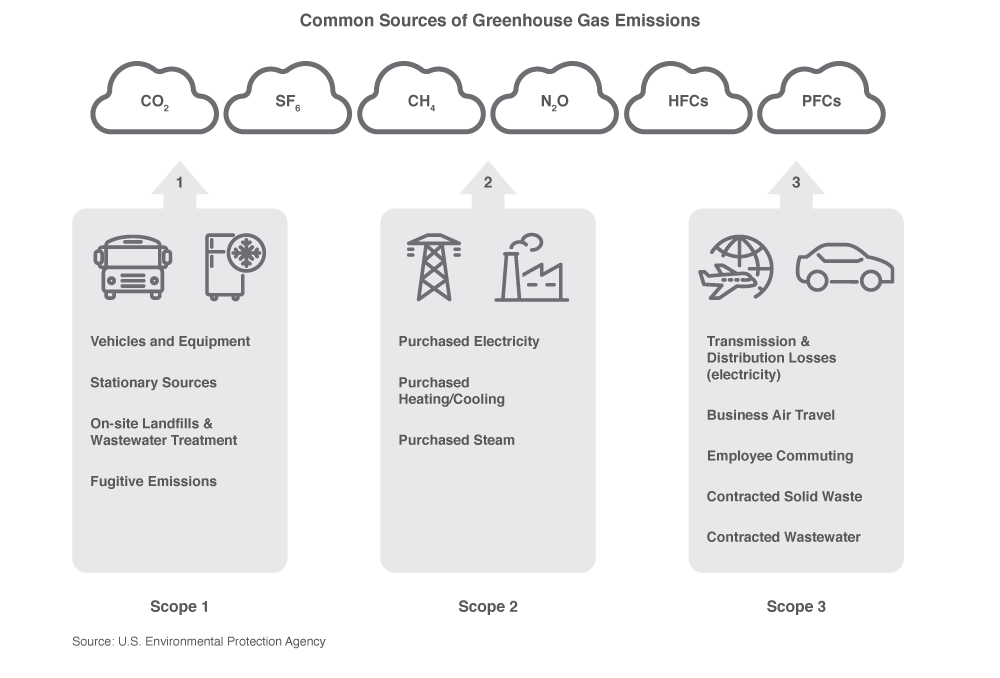
Scope 1: Direct Emissions
Scope 1 emissions are direct emissions from sources owned and operated by the business.3 Some of the largest contributors to Scope 1 emissions include manufacturing, gas heating systems, refrigerants and company vehicles/ planes. At an industry level, airline, oil and gas, utilities and manufacturing companies typically have the highest Scope 1 emissions. Companies in these industries are increasingly investing in alternative strategies such as carbon sequestration — the process of removing and storing atmospheric carbon dioxide — to offset their Scope 1 emissions. While this approach does have a positive environmental impact, it is reactive and does not provide the direct financial benefits of proactive sustainability solutions.
Scope 2: Indirect Emissions
Scope 2 emissions are indirect emissions produced by energy generation.4 When the energy is purchased, these emissions are transferred to the buyer. Because grid-based electricity is generated primarily through fossil fuels,5 firms with traditional energy procurement practices will have a higher carbon footprint.
Companies in retail, grocery, telecom and internet, for instance, are particularly exposed to high Scope 2 emissions. Renewable energy solutions provide an opportunity for such businesses to tackle their largest source of emissions and lower their carbon footprint substantially.
Scope 3: Tertiary Emissions
Scope 3 emissions cover all emissions caused by activities that are not directly owned or controlled by the business. Examples of Scope 3 emissions include those produced by business travel, waste, packaging, purchased goods and agriculture.
Supply chain emissions also count toward Scope 3 and come primarily from freight transportation. In a global economy, goods travel long distances before they reach the end consumer, and more travel means more emissions.
These emissions vary greatly based on the method of transportation. Air travel is significantly worse than all other modes of transportation, while ocean freight — a clear alternative to air travel — generally produces the least emissions (as indicated in the graph below). Although these emissions are not directly owned by the business, they exist because of its supply chain. This means everyday products can indirectly cause significant environmental damage.
Procurement teams can limit Scope 3 emissions in many ways, such as by partnering with suppliers who operate sustainably. Because these emissions are indirect and unowned, the most effective reduction strategies involve carbon offset programs that reactively counter Scope 3 emissions.
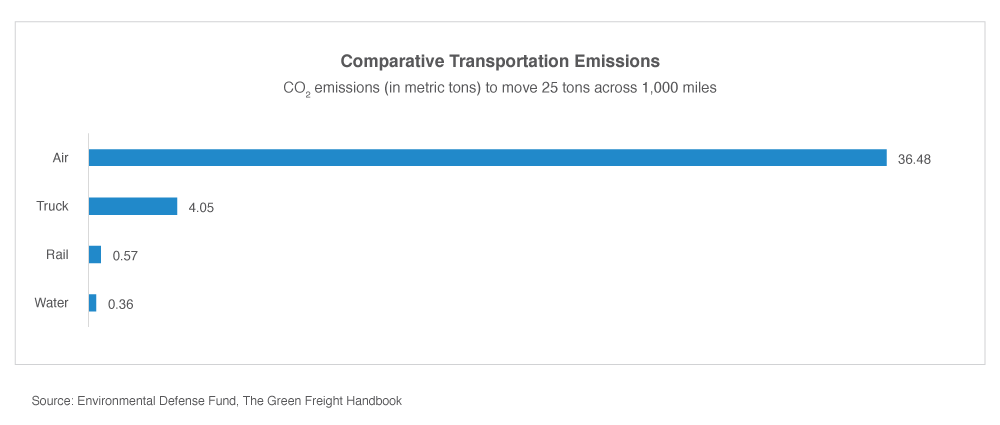
Reducing greenhouse gas emissions is essential to sustainability. While there are many innovative strategies for lowering all three scopes, the most cost-effective and proactive way to achieve sustainability goals is to target Scope 2 emissions by switching to renewable energy sources.
MOVING TO A RENEWABLE FUTURE
Fuel costs are one of the most expensive components of operation over the lifetime of a traditional energy generation project.6
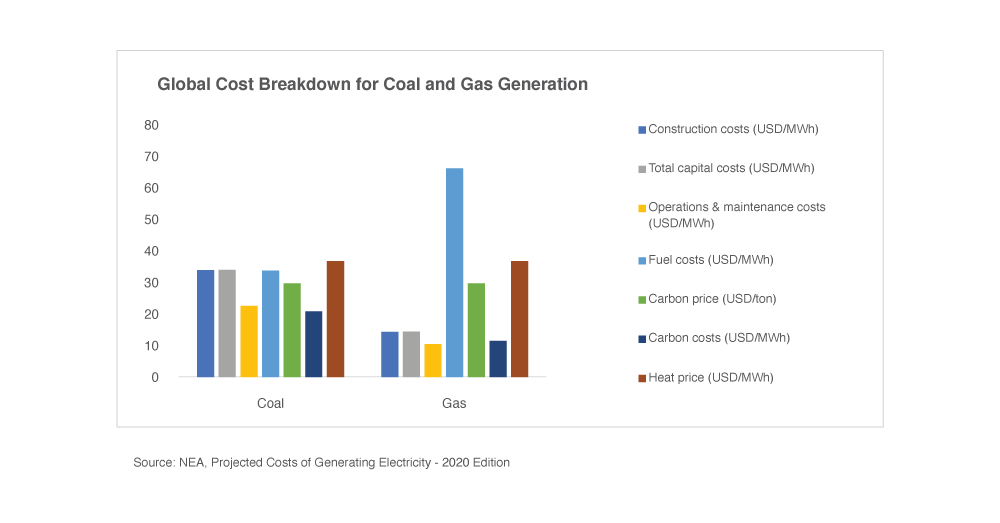
The extraction of fossil fuels is an expensive, complex process that is impacted by resource availability, regulations, and national interests, all of which combine to make fossil fuel prices volatile and difficult to project.
No display of volatility was as dramatic as the collapse of oil prices starting March 2020.7 As global travel and overall economic activity came to a standstill, oil prices crashed, leaving some of the world’s leading energy companies scrambling for their next move.
Meanwhile, utility companies with significant investments in renewable energy have enjoyed unparalleled growth as the industry’s exposed fragility has further shaped investors’ views about the future of energy.8
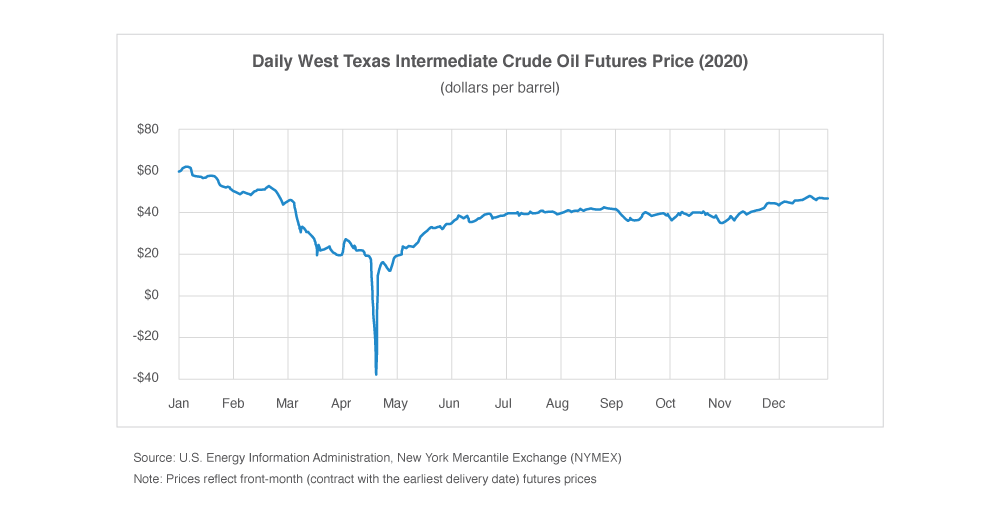
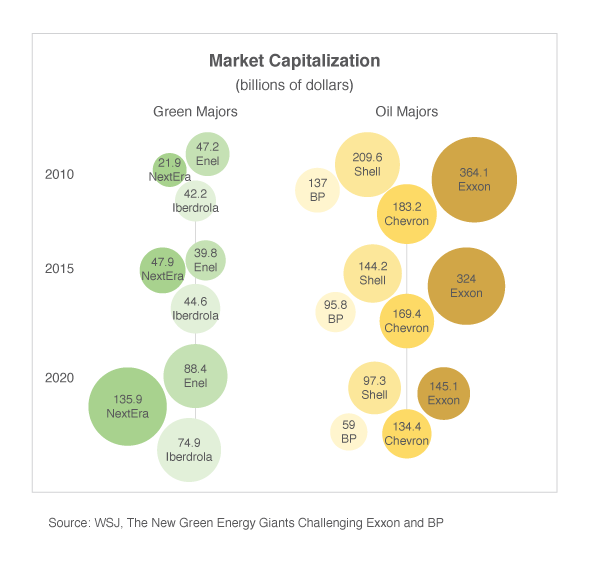
Although natural resources like wind and solar vary in availability, they are free, meaning renewable energy generation eliminates the commodity cost and its related volatility. Further, according to GEP’s analysis, electricity generation from renewable sources has reached or surpassed price parity with traditional grid electricity rates, which means that renewables have become cheaper sources of energy than fossil fuels.
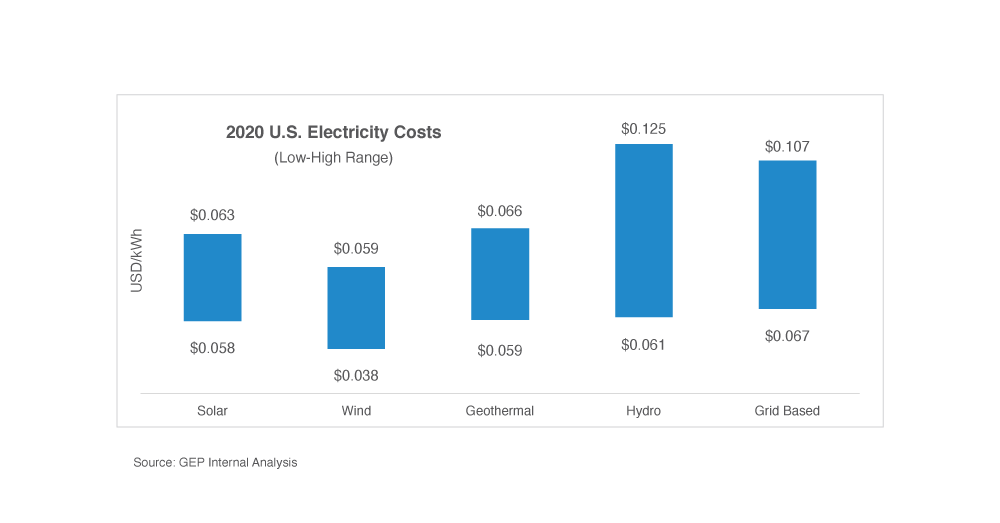
Renewable energy prices are calculated using the Levelized Cost of Electricity (LCOE), a metric created to accurately price renewable generation in the absence of commodity cost. LCOE takes into consideration installation costs, operations and maintenance (O&M) costs, efficiency, economic lifetime and the cost of capital. Over the past decade, installation and O&M costs have fallen, while efficiency and economic lifetime have risen, leading to a substantially lower LCOE.9
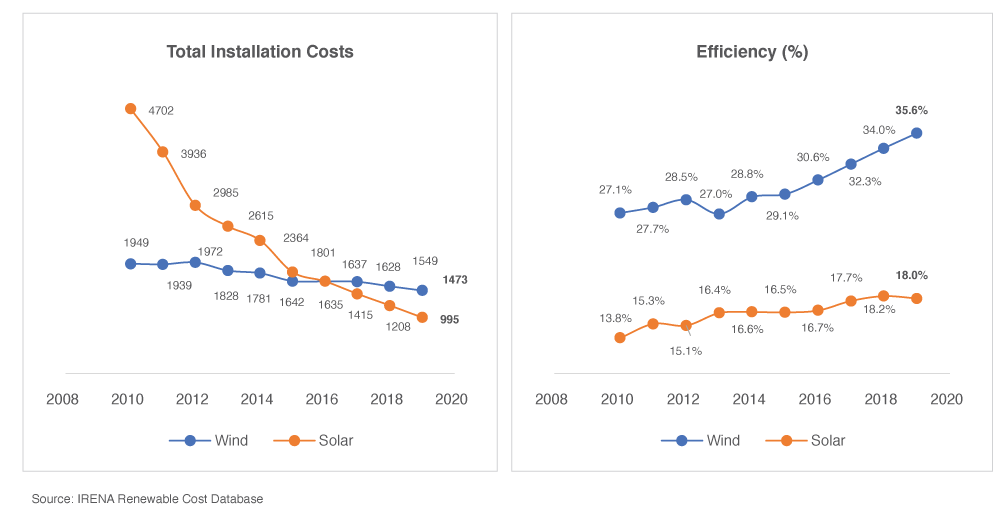
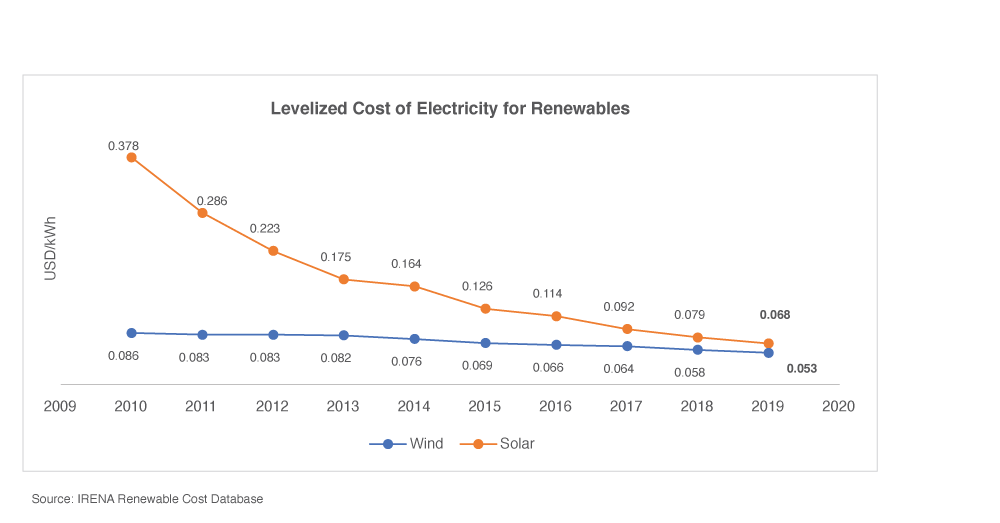
Nonetheless, a complete industry transition will take time — time that procurement teams do not have if they want to get ahead. Meeting energy sustainability goals requires that procurement take a proactive, forward-thinking approach because depending on traditional energy procurement practices means depending on the progress of the energy industry at large.
THREE WAYS TO ADOPT SUSTAINABLE SOLUTIONS
To take advantage of the renewable energy transition, businesses may need to look beyond their local utilities and explore Renewable Energy Credits (RECs), Power Purchase Agreements (PPAs), On-Site Generation, or even form new, innovative partnerships with renewables-focused utilities. These strategies will allow companies to reduce their greenhouse gas emissions and gain significant financial benefits.
The option that is best suited to your business depends on capital availability, real estate ownership and sustainability goals.
Renewable Energy Credits
RECs are the vehicle by which many companies in the U.S. meet their renewable energy goals. A REC is produced each time 1 megawatt-hour (MWh) of renewable electricity is delivered to the power grid; each REC that a firm receives counts as 1 MWh of renewable electricity usage.
Firms that wish to take a more passive approach to their energy sustainability can procure RECs directly, avoiding the risks and challenges of long-term contracts and energy generation. RECs purchased in such a way are labeled as “unbundled” as they are completely disconnected from their associated electricity. While this approach offers a simple way for buyers to check the box on sustainability goals, it does not support the generation of new renewable power, for which far more effective strategies can be deployed.
Power Purchase Agreements
PPAs — physical or virtual — are great options for enterprises seeking to procure renewable energy without incurring the upfront costs of installation or the O&M burden of ownership. Corporate PPAs are long-term contracts, structured around the transfer of RECs, between developers of renewable energy projects and businesses that agree to a fixed price.
PPAs also offer enterprises the opportunity to fund new renewable energy developments. This means that corporations can contribute to their local communities through the jobs created by their projects.
Physical PPAs: In physical PPAs, the developer transfers the legal title to the energy to the business at a specific delivery point, so the business receives the RECs and the electricity directly.10
Physical PPAs are ideal for sites with consistent, predictable power usage, such as large data centers. As electricity from the renewable development is transferred directly to the facility, businesses will know exactly how much of their load is covered by the PPA.
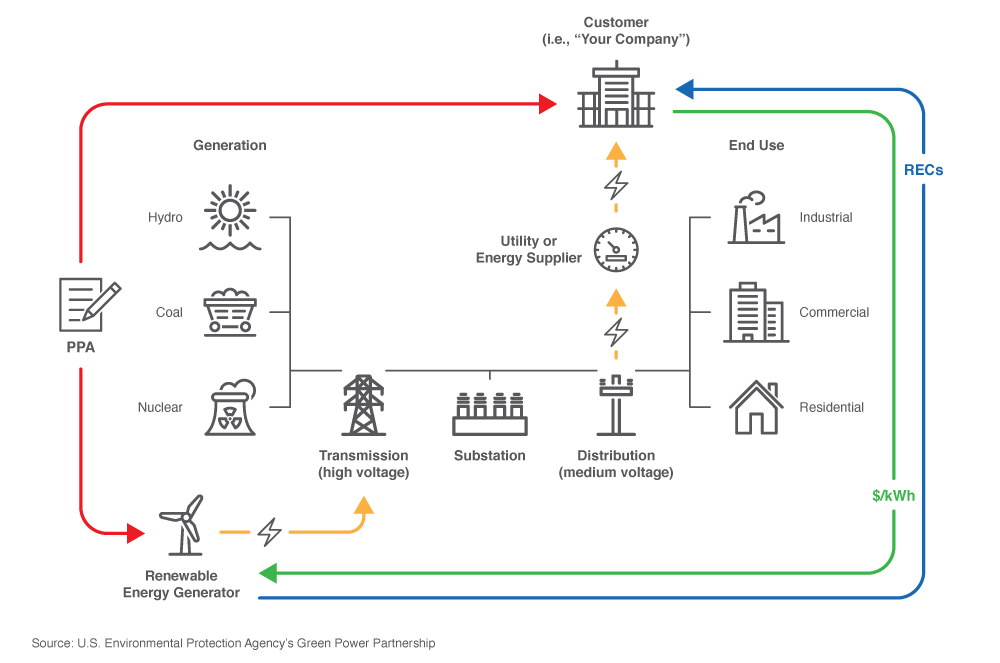
Unfortunately, physical PPAs are geographically constrained by resource availability and market regulations. Physical PPAs only make economic sense if your facility is near suitable sun or wind locations as lengthy transmissions will increase costs. Also, retail and wholesale regulations can make physical PPAs quite complex. To engage in a physical PPA, the buyer must be in a competitive retail market and the developer must be in a competitive wholesale market that is interconnected with the buyer’s Independent System Operator (ISO).
While physical PPAs are not a universal solution, they provide tangible environmental benefits because the clean energy is transferred directly to your business.
Virtual PPAs: In VPPAs, the renewable energy developer sells electricity to the grid, transfers the RECs to the business, and the two parties settle the price difference between the market rate received and the fixed PPA price. These contracts are sometimes referred to as Financial PPAs as there is no delivery of power, only a financial hedging strategy. If your developer’s project is highly efficient and market rates trend above your fixed price, virtual PPAs can be a source of revenue.
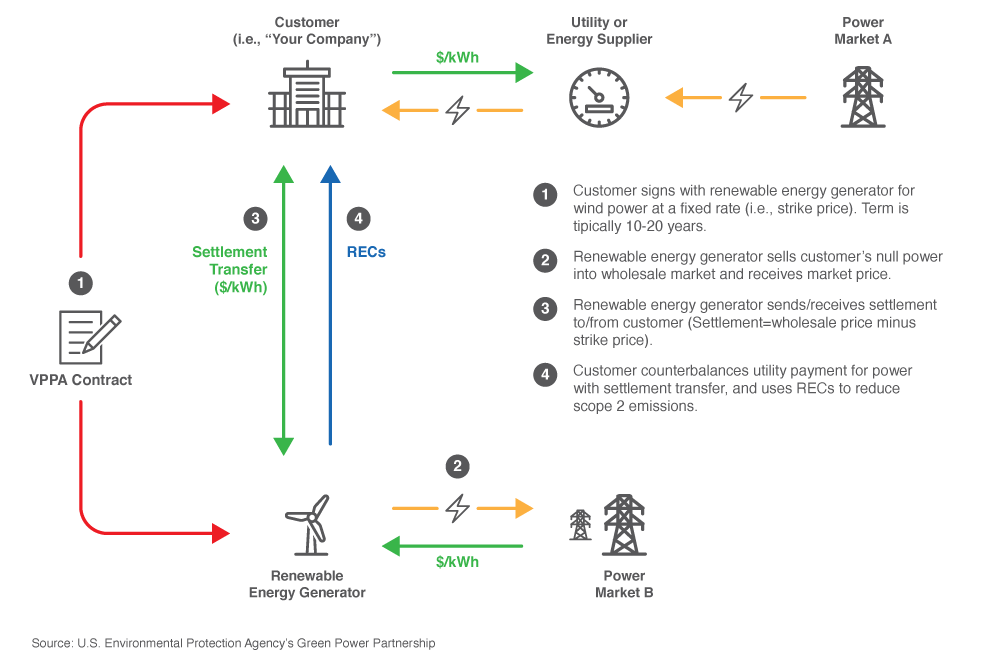
Virtual PPAs have fewer constraints than physical PPAs. As the developer sends electricity directly to the grid, the project can be in any competitive wholesale market. This means the developer can build in locations most suitable for wind and solar instead of being restricted by the firm’s location.
The profitability of VPPAs depends on wholesale market rates, but various pricing structures allow companies to minimize their risk. Collared contracts, where both parties agree to maximum settlements in either direction, and upside share contracts, where both parties split the positive settlement in exchange for a lower fixed price, are common methods of risk mitigation.
Although VPPAs don’t guarantee the direct use of clean energy the same way physical PPAs do, they offer flexible financial strategies that support the generation of renewable electricity without the geographical constraints of physical PPAs.
On-Site Generation
Generating your own electricity from renewable sources is a great option for organizations with significant real estate and capital. On-site solar power generation is more common than wind because it requires less space. Although there is significant upfront investment, installation costs have fallen substantially over the last decade.11
Benefits vary across states in the U.S., but there are generally significant tax credits for on-site generation that can mitigate upfront costs. Firms can also lease equipment, which will minimize upfront investment but increase long-term payments and pass the tax credits to the utility.
Companies can also sell the RECs they generate while still using the electricity. This option helps offset some of the costs of on-site generation as the project provides a steady source of revenue through the REC market.
Understanding Timeframes
While grid-based electricity still depends on fossil fuels, renewable energy projects will yield savings for your business. It is important to note, though, that such projects typically have long-term time horizons. For example, PPAs typically last at least 10-25 years as developers need guaranteed long-term revenue to justify the capital costs.12
For on-site generation, the payback period — the time until energy bill savings equal the project’s upfront capital costs — depends on the firm’s previous electricity rates and the project’s efficiency. GEP’s internal analysis estimates that such projects typically reach their payback period within 4-7 years of installation.
CORPORATE BENEFITS OF SUSTAINABILITY
In this time of social activism, consumers and investors have rallied together to use their dollars as vehicles for change. Sustainability provides an opportunity for procurement to meet this moment and drive value beyond savings.
In the financial markets, Environmental, Social, Governance (ESG) funds attracted a substantial inflow of capital in 2020 as the global economic downturn and social unrest revealed the importance of a company’s impact on society.13 The boom in ESG investing is not driven only by ethics and social concerns; it also reflects investors’ beliefs about what will make businesses successful in the long term. As consumers boycott products, force rebrandings and seek to minimize their carbon footprints, ESG data provides investors insight into which enterprises are best prepared to survive and even capitalize on these movements.
Beyond Wall Street, the youngest generation of consumers — a group vital to the long-term success of any business — is leading the charge in climate activism. To earn their support and bolster future revenue, businesses must prioritize sustainability
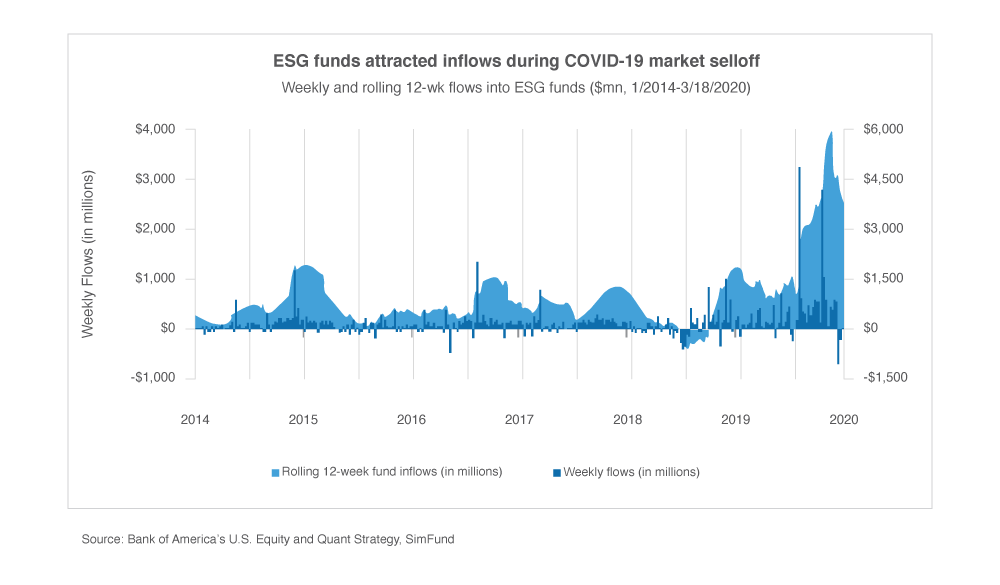
GROWING YOUR TRIPLE BOTTOM LINE
Companies always work to maximize their bottom line, often sidelining projects that don’t deliver short-term profitability. However, environmental concerns, social activism and ethically conscious consumers have forced businesses to reconsider the consequences and shortcomings of this traditional approach.
Today, organizations must maximize their triple bottom line — a metric used to measure a firm’s success in driving profit, empowering people and protecting the planet.14 The interconnectedness of these three facets means that corporations who fail to meet social and environmental expectations will struggle to maximize profit.
For procurement, the energy category offers an opportunity to grow the triple bottom line. Renewable energy solutions will bring savings, reduce emissions and create new jobs while simultaneously enhancing consumer trust and brand loyalty. Sustainability is becoming synonymous with success. Attacking emissions, one clean electron at a time, will put your business on the path to true sustainability.
This paper has been co-authored by Jason Allukian, Micah Sze and Charlie Maxwell.
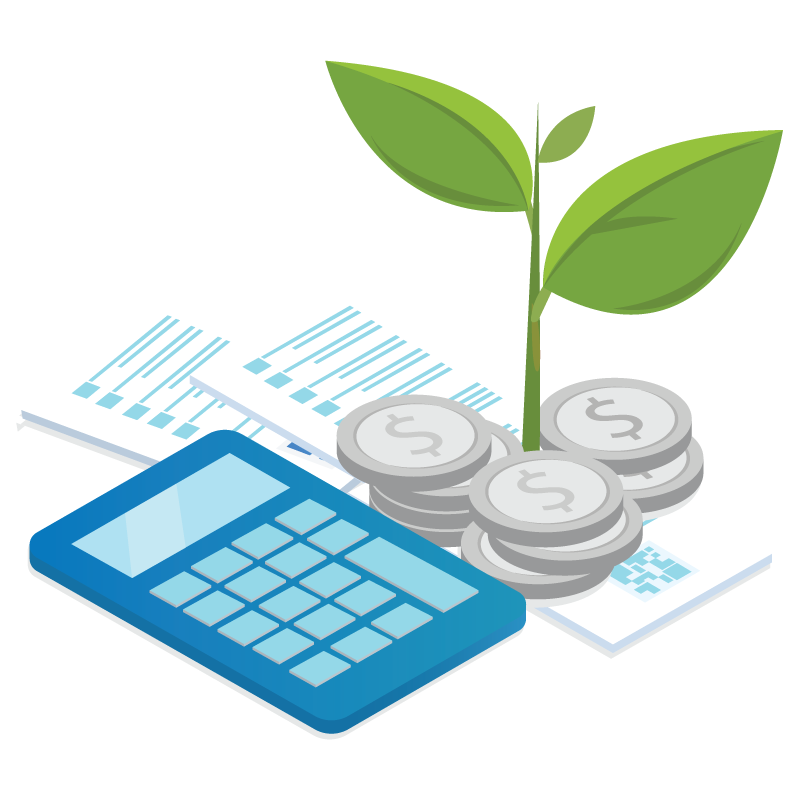
References
- “Statistical Review of World Energy 2020,” BP, 17 June 2020 | https://www.bp.com/content/dam/bp/business-sites/en/global/corporate/pdfs/energy-economics/statistical-review/bp-stats-review-2020-full-report.pdf
- “Sustainable Procurement,” UNDP | https://www.undp.org/content/undp/en/home/procurement/sustainable-procurement.html
- “Greenhouse Gases at EPA,” United States Environmental Protection Agency | https://www.epa.gov/greeningepa/greenhouse-gases-epa
- Ibid.
- “Power Profiler: How Clean Is the Electricity You Use?” United States Environmental Protection Agency | https://www.epa.gov/egrid/power-profiler#/
- “Projected Costs of Generating Electricity - 2020 Edition,” Nuclear Energy Agency, OECD | https://www.oecd-nea.org/jcms/pl_51110/projectedcosts-of-generating-electricity-2020-edition
- “EIA’s AEO2021 Reference Case Shows Crude Oil Production Plateauing After 2030,” U.S. Energy Information Administration, 4 February 2021 | https://www.eia.gov/todayinenergy/detail.php?id=46656
- Katherine Blunt and Sarah McFarlane, “The New Green Energy Giants Challenging Exxon and BP,” The Wall Street Journal, 11 December 2020 | https://www.wsj.com/articles/the-new-green-energy-giants-challenging-exxon-and-bp-meet-nextera-enel-11607696660
- “Renewable Power Generation Costs in 2019,” IRENA, June 2020 | https://www.irena.org/publications/2020/Jun/Renewable-Power-Costs-in-2019
- “Introduction to Virtual Power Purchase Agreements,” U.S. EPA’s Green Power Partnership | https://www.epa.gov/sites/production/files/2016-09/documents/webinar_kent_20160928.pdf
- “Renewable Power Generation Costs in 2019,” IRENA, June 2020 | https://www.irena.org/publications/2020/Jun/Renewable-Power-Costs-in-2019
- “LevelTen Releases Q3 2020 PPA Price Index Reports for North America and Europe,” LevelTen Energy, 15 October 2020 | https://leveltenenergy.com/blog/ppa-price-index/q3-2020/
- “The Growing Role of ESG,” Bank of America | https://www.bofaml.com/en-us/content/esg-research/esg-investing-performance-trends.html
- Hanan Alhaddi, “Triple Bottom Line and Sustainability: A Literature Review,” Redfame Publishing, 3 April 2015 | https://pdfs.semanticscholar.org/9afb/4ab4721ae27f6e04bd6055247cd9f484ba42.pdf?_ga=2.6502197.661542136.1610379169-1141489147.1610379169

